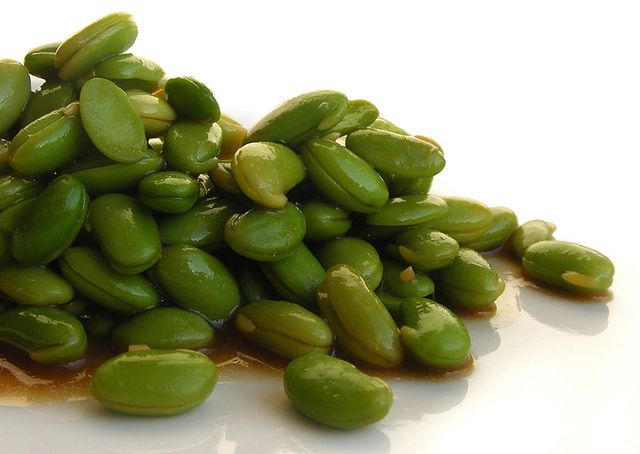Podcast: Play in new window | Download
Subscribe: RSS

One of the worst things you could eat is a fresh soybean -- even sauteed, as these have been. But there are lots of soy products that are even worse. (Photo by FotoosVanRobin/Flickr)
Once upon a time there was a lowly bean. Unlike other beans, in its natural state it was highly toxic to people and animals. Poor people in Asia discovered somehow — no doubt through desperate trial-and-error — that when fermented, the soy bean was edible. It became part of their diet. In the late 20th Century, when the industrialized diet of the West was afflicting its people with heart disease, cancers and diabetes, it was noticed that the spare Asian diet of fish, rice and a little fermented soy bean was not making people sick. Thus began one of the largest and most successful food cons ever perpetrated.
It’s the kind of silly syllogism that industry has used to make money over and over again: Asians eat soy; Asians are healthy; therefore eating soy is healthy. You might as well argue that surgically altering your eyes, or staining your skin, would give you the health of a hard-working Asian.
But when industry invests hundreds of millions of dollars in repeating a stupid statement on television, and hires scientists to inquire into its validity, and then hires actors in white lab coats to explain that the scientists agreed with the stupid statement, then instead of the ridicule the statement deserves you end up with FDA approval (it came in in 1999) of the following food label: “Diets low in saturated fat and cholesterol that include 25 grams of soy protein a day may reduce the risk of heart disease.”
Yes, the soybean industry, now worth about $4 billion a year in the United States alone, now responsible for much of the forest and topsoil destruction proceeding apace around the world, hired the scientists who did the study that said soy “may reduce the risk” of heart disease. Say those words fast enough, often enough, and they sound just like “prevents” or even “cures.” Thus does $4 billion become $8 billion, and $16 billion, and so on.
It is not the case that industry brought the soy that Asians were consuming — small portions of fermented soy such as miso, natto and tempeh, with a little tofu — to market in the rest of the world. Instead, the food engineers deconstructed the bean into ingredients: oil (now the base of most vegetable oils sold), lecithin, the waste from the oil manufacture (used as an emulsifier), soy flour and various soy-protein “isolates” (originally developed to make cardboard) used as mixes for various drinks that are advertised as health- promoting.
Where the typical Japanese or Chinese diet traditionally included about nine grams of mostly fermented soy bean per day, the typical Western soy snack contains 20 grams of unfermented soy per serving. Among the actual health effects of unfermented soy, with its plant estrogens, toxins, and antinutrients (as documented, among other places, in the fall 2011 issue of the newsletter of the American Nutrition Association):
- Raw soybean is an anti-coagulant that prevents blood clotting by supressing the body’s production of trypsin, an enzyme needed to digest protein and assimilate vitamin B12.
- Antinutrients in soy block enzymes needed for digestion, and its phytates block absorption of essential minerals (especially zinc, calcium, and magnesium). This is most worrisome for vegans and vegetarians who eat soy as their main source of protein, and for women in menopause who up their soy intake through supplements.
- Soy contains phytochemicals–plant nutrients with disease-fighting activity–called isoflavones. Studies claim isoflavones can mimic estrogens, and suppress the body’s production of them. High estrogen levels have been linked to cancers of the reproductive system in women. (Silly syllogism alert!!) Therefore, soy prevents breast cancer!! However, recent human and animal studies suggest that soy may increase the risk of breast cancer.
- Animal studies relate the isoflavones in soy to thyroid disorders, including goiter. Other studies relate soybean consumption not only to hypothyroidism, but also to low energy levels, poor mineral absorption, and infertility.
- Soy protein causes negative calcium balance in humans and other animals and can contribute to the development of osteoporosis. Also, the high heat used in processing the isolates has been reported to increase the likelihood of forming carcinogenic compounds.
- Perhaps the worst of all soy products is soy milk used as formula for infants. The estrogens in soy affect the hormonal development of children, along with their growing brains, reproductive systems, and thyroids. Soy formula contains large amounts of manganese, which has been linked to attention deficit disorder and neurotoxicity in infants.
-0-
[For updates on this and other Daily Impact stories, and for short takes on other subjects, check out The Editor’s Log.]
There’s another article I came across on soy. Here it is:
http://www.savvyvegetarian.com/articles/soy-truth.php
And, to make matters worse–if that’s possible–85% or more of U.S. soy crops are genetically modified.